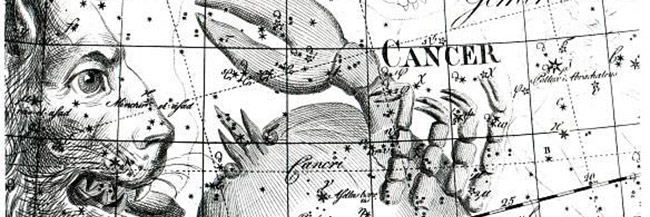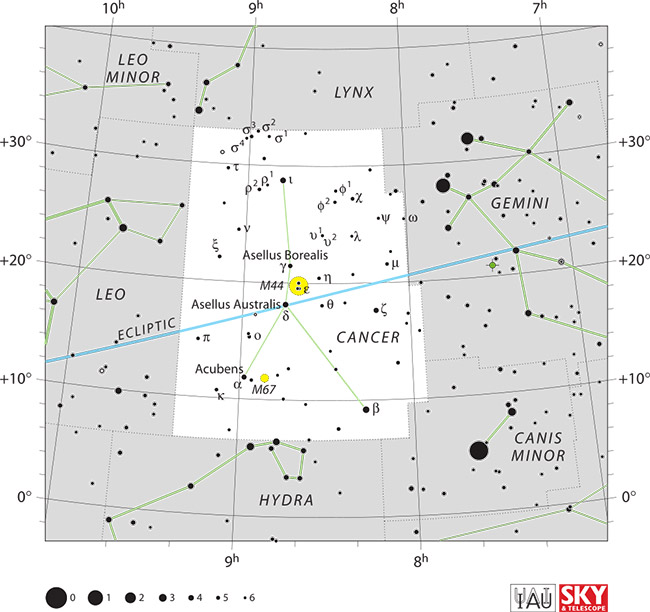Cancer – Constellation Facts
 Alessio Govi, Public domain, via Wikimedia Commons
Alessio Govi, Public domain, via Wikimedia Commons
Cancer means “the crab” in Latin and is the faintest of the 12 zodiac signs. It can be found in the second quadrant of the Northern hemisphere and is located specifically between latitudes of +90° and -60°. Like all the Zodiac signs, Cancer was first catalogued in the 2nd century by Ptolemy, who was a Greek astronomer.
Constellation Characteristics
Cancer takes on the form of an upside down “Y” shape. It is the 31st largest constellation in the night sky, occupying 506 square degrees. Cancer is also neighbors with Canis Minor, Gemini, Hydra, Leo, Leo Minor and Lynx. In addition, this constellation has eight stars, two Messiers and one meteor shower (Delta Cancridae) associated with it.

IAU and Sky & Telescope, CC BY 4.0, via Wikimedia Commons
By IAU and Sky & Telescope magazine (Roger Sinnott & Rick Fienberg) CC BY 3.0, via Wikimedia CommonsPlanetary Systems
[inlinetweet prefix=”” tweeter=”OSRorg” suffix=””]Cancer has six deep sky objects. Read on to discover some fascinating facts about these celestial wonders.[/inlinetweet]
- Beehive Cluster (Praesepe, Messier 44, M44, NGC 2632, Cr 189): estimated to be around 600 million years old, this open star cluster is one of the most populated and closest to the solar system. It is also known by the name of, Praesepe and contains at least 1,000 stars. This cluster is even visible to the naked eye.
- Messier 67 (M67, NGC 2682): known for being one of the oldest open clusters, M67 is estimated to be from 3.2 to 5 billion years-old. This Messier also contains approximately 100 stars similar to the Sun.
- NGC 2775 (Caldwell 48): having had recent star forming activity this spiral galaxy is a wonder to behold. It contains several spiral arms and has an apparent magnitude of 11.03.
- NGC 2535 & NGC 2536: this pair of celestial marvels are interacting with each other. The first is catalogued as a unbarred spiral galaxy, while the second is a barred spiral.
- NGC 2500: located 33 million light-years away, this barred spiral galaxy has an H II nucleus.
- NGC 2608 (Arp 12): considered a grand design spiral galaxy, NGC 2608 is 62,000 light-years across. It is also notable for the winding of its arms around the prominent central bar.
Main Stars
The constellation Cancer contains eight main stars that makes up its shape. Let’s explore them further.
- Al Tarf (Beta Cancri) shines the brightest in the Cancer constellation (which will be discussed later in detail).
- Acubens (Alpha Cancri) is sometimes referred to as Al Zubanah (derived from Arabic, az-zubanah, meaning ‘claws) and Sertan (saratan, meaning ‘the crab’). Acubens is also the fourth brightest star in Cancer.
- Asellus Australis (Delta Cancri) marks the location of the famous Beehive Cluster.and is the second brightest star in Cancer. This star is also known by the longest name of them all (Arkushanangarushashutu) which is Babylonian for “the Southeast star in the crab.”
- Asellus Borealis (Gamma Cancri) is a white A-type subgiant with a mythological name meaning, “Northern donkey colt.” After the clash of the Titans, the gods went to war against the giants (where they rode donkeys into battle). Having never heard the voice of a donkey, the giants fled and as a commemorative of this victory these animals were placed in the heavens as stars.
- 55 Cancri is a double star that was confirmed (in 2010) to have five extrasolar planets orbiting it.
- Tegmine (Zeta Cancri) is located 83.4 light-years from Earth and is composed of multiple stars. Its name means “shell of the crab.”
- Lambda Cancri lies approximately 419 light-years away and is considered a blue-white B-type main sequence dwarf star.
- Xi Cancri is a spectroscopic binary star that has a yellow G-type giant as its main component.

Alessio Govi, Public domain, via Wikimedia Commons
Cancer, from Chart XIII of Johann Bode’s Uranographia (1801)Most Shining Star
Out of all the stars that make up the Cancer constellation, none shine brighter than Al Tarf. Its name is derived from the Arabic (at-tarf) meaning “eye” or at-tarfah, meaning “the glance (of Leo”). This binary star has an orange K-type giant as its main component and is 290 light-years away.
Mythology & History
One of the legends of the Cancer constellation pertains to Hercules and his Twelve Labors. As the story goes, a crab was sent to Hercules, by Hera (sworn enemy) to distract him in the battle with the Lernaean Hydra – a many-headed serpent-like creature with poisonous breath. As the crab tries to kill Hercules, he kicks it with all his strength, sending it into the stars.
In another version of the myth, the crab is crushed while trying to kill Hercules, so Hera places it into the sky to commemorate its efforts; however, she places it in a dark region because it was unsuccessful in its task.
Astrology
Cancer is the fourth sign of the zodiac. People born between June 22nd and July 22nd are in this sign of the crab. Some characteristics of people born under this sign are;
- Adaptable
- Caring
- Loyal
- Responsive
- Dependable
Cancers do tend to be a bit moody, oversensitive and clingy. They have the ability to be very independant; however, if they aren’t fully self-actualized they will constantly be looking for the help of others. This sign craves the attention and comfort from people and for this reason are happiest with a small, but close-knit group of friends. Cancers may be a bit insecure at times, but once they resolve this issue, there is nothing they can’t do.
Cancer is a fascinating constellation, so the next time you are gazing into the night sky, be sure to search out this intriguing figuration of stars.
